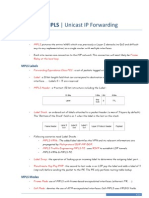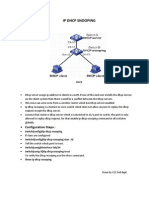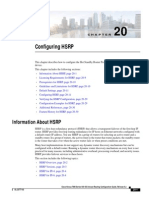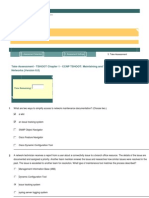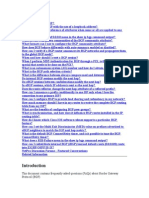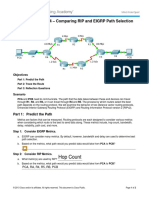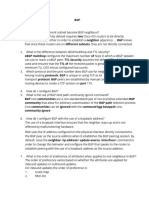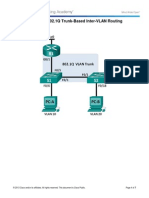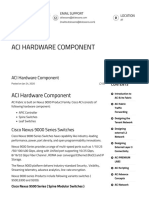Igmp Snoop
Igmp Snoop
Uploaded by
cetinalicanCopyright:
Available Formats
Igmp Snoop
Igmp Snoop
Uploaded by
cetinalicanCopyright
Available Formats
Share this document
Did you find this document useful?
Is this content inappropriate?
Copyright:
Available Formats
Igmp Snoop
Igmp Snoop
Uploaded by
cetinalicanCopyright:
Available Formats
Se n d d o c u m e n t c o m m e n t s t o n ex u s 7 k - d o c f e e d b a ck @ c i s c o .
c o m
CH A P T E R
Configuring IGMP Snooping
This chapter describes how to configure Internet Group Management Protocol (IGMP) snooping on a Cisco NX-OS device. This chapter includes the following sections:
Information About IGMP Snooping, page 5-1 Licensing Requirements for IGMP Snooping, page 5-4 Prerequisites for IGMP Snooping, page 5-5 Guidelines and Limitations for IGMP Snooping, page 5-5 Default Settings, page 5-6 Configuring IGMP Snooping Parameters, page 5-6 Verifying IGMP Snooping Configuration, page 5-16 Displaying IGMP Snooping Statistics, page 5-17 Configuration Example for IGMP Snooping, page 5-17 Where to Go Next, page 5-17 Additional References, page 5-18 Feature History for IGMP Snooping in CLI, page 5-18
Information About IGMP Snooping
Note
We recommend that you do not disable IGPM snooping on the device. If you disable IGMP snooping, you might see reduced multicast performance because of excessive false flooding within the device. IGMP snooping software examines Layer 2 IP multicast traffic within a VLAN to discover the ports where interested receivers reside. Using the port information, IGMP snooping can reduce bandwidth consumption in a multi-access LAN environment to avoid flooding the entire VLAN. IGMP snooping tracks which ports are attached to multicast-capable routers to help the routers forward IGMP membership reports. The IGMP snooping software responds to topology change notifications. By default, IGMP snooping is enabled on the device.
Cisco Nexus 7000 Series NX-OS Multicast Routing Configuration Guide OL-23238-01
5-1
Chapter 5 Information About IGMP Snooping
Configuring IGMP Snooping
S e n d d o c u m e n t c o m m e n t s t o n ex u s 7 k - d o c f e e d b a ck @ c i s c o . c o m
Figure 5-1 shows an IGMP snooping switch that sits between the host and the IGMP router. The IGMP snooping switch snoops the IGMP membership reports and Leave messages and forwards them only when necessary to the connected IGMP routers.
Figure 5-1 IGMP Snooping Switch
IGMP Router
IGMP Query Messages
IGMP Snooping Switch
IGMP Report and Leave Messages
The IGMP snooping software operates upon IGMPv1, IGMPv2, and IGMPv3 control plane packets where Layer 3 control plane packets are intercepted and influence the Layer 2 forwarding behavior. For more information about IGMP, see Chapter 2, Configuring IGMP. The Cisco NX-OS IGMP snooping software has the following proprietary features:
Source filtering that allows forwarding of multicast packets based on destination and source IP. Multicast forwarding based on IP addresses rather than MAC address. Beginning with Cisco Release 5.2(1) for the Nexus 7000 Series devices, multicast forwarding alternately based on the MAC address Optimized multicast flooding (OMF) that forwards unknown traffic to routers only and performs no data-driven state creation.
For more information about IGMP snooping, see RFC 4541. This section includes the following topics:
IGMPv1 and IGMPv2, page 5-3 IGMPv3, page 5-3 IGMP Snooping Querier, page 5-3 Static Multicast MAC Address, page 5-4 IGMP Snooping with VDCs and VRFs, page 5-4
Cisco Nexus 7000 Series NX-OS Multicast Routing Configuration Guide
5-2
240804
Host
OL-23238-01
Chapter 5
Configuring IGMP Snooping Information About IGMP Snooping
Se n d d o c u m e n t c o m m e n t s t o n ex u s 7 k - d o c f e e d b a ck @ c i s c o . c o m
IGMPv1 and IGMPv2
Both IGMPv1 and IGMPv2 support membership report suppression, which means that if two hosts on the same subnet want to receive multicast data for the same group, then the host that receives a member report from the other host suppresses sending its report. Membership report suppression occurs for hosts that share a port. If no more than one host is attached to each VLAN switch port, you can configure the fast leave feature in IGMPv2. The fast leave feature does not send last member query messages to hosts. As soon as the software receives an IGMP leave message, the software stops forwarding multicast data to that port. IGMPv1 does not provide an explicit IGMP leave message, so the software must rely on the membership message timeout to indicate that no hosts remain that want to receive multicast data for a particular group.
Note
The software ignores the configuration of the last member query interval when you enable the fast leave feature because it does not check for remaining hosts.
IGMPv3
The IGMPv3 snooping implementation on Cisco NX-OS supports full IGMPv3 snooping, which provides constrained flooding based on the (S, G) information in the IGMPv3 reports. This source-based filtering enables the device to constrain multicast traffic to a set of ports based on the source that sends traffic to the multicast group. By default, the software tracks hosts on each VLAN port. The explicit tracking feature provides a fast leave mechanism. Because every IGMPv3 host sends membership reports, report suppression limits the amount of traffic that the device sends to other multicast-capable routers. When report suppression is enabled, and no IGMPv1 or IGMPv2 hosts requested the same group, the software provides proxy reporting. The proxy feature builds the group state from membership reports from the downstream hosts and generates membership reports in response to queries from upstream queriers. Even though the IGMPv3 membership reports provide a full accounting of group members on a LAN segment, when the last host leaves, the software sends a membership query. You can configure the parameter last member query interval. If no host responds before the timeout, the software removes the group state.
IGMP Snooping Querier
When PIM is not enabled on an interface because the multicast traffic does not need to be routed, you must configure an IGMP snooping querier to send membership queries. You define the querier in a VLAN that contains multicast sources and receivers but no other active querier. When an IGMP snooping querier is enabled, it sends out periodic IGMP queries that trigger IGMP report messages from hosts that want to receive IP multicast traffic. IGMP snooping listens to these IGMP reports to establish appropriate forwarding.
Cisco Nexus 7000 Series NX-OS Multicast Routing Configuration Guide OL-23238-01
5-3
Chapter 5 Licensing Requirements for IGMP Snooping
Configuring IGMP Snooping
S e n d d o c u m e n t c o m m e n t s t o n ex u s 7 k - d o c f e e d b a ck @ c i s c o . c o m
Static Multicast MAC Address
Beginning with the Cisco Release 5.2(1) for the Nexus 7000 Series devices, you configure an outgoing interface statically for a multicast MAC address. Also, you can configure the IGMP snooping to use a MAC-based lookup mode. Previously, the system performs the lookup on Layer 2 multicast table using the destination IP address rather than the destination MAC address. However, some applications share a single unicast cluster IP and multicast cluster MAC address. The system forwards traffic destined to the unicast cluster IP address by the last-hop router with the shared multicast MAC address. This action can be accomplished by assigning a static multicast MAC address for the destination IP address for the end host or cluster. The default lookup mode remains IP, but you can configure the lookup type to MAC address-based. You can configure the lookup mode globally or per VLAN:
If the VDC contains ports from only an M Series module and the global lookup mode is set to IP, VLANs can be set to either one of the two lookup modes. But, if the global lookup mode is set to MAC address, the operational lookup mode for all the VLANs changes to MAC-address mode. If the VDC contains ports from both an M Series module and an F Series module and if you change the lookup mode to a MAC address in any VLAN, the operation lookup mode changes for all of the VLANs to a MAC-address based. With these modules in the chassis, you have the same lookup mode globally and for the VLANs. Similarly, if the global lookup mode is MAC-address based, the operational lookup mode for all VLAN is also MAC-address based.
Note
Changing the lookup mode is disruptive. Multicast forwarding is not optimal until all multicast entries are programmed with the new lookup mode. Also, when 32 IP addresses are mapped to a single MAC address, you might see suboptimal forwarding on the device.
IGMP Snooping with VDCs and VRFs
A virtual device context (VDC) is a logical representation of a set of system resources. Within each VDC, you can define multiple virtual routing and forwarding (VRF) instances. One IGMP process can run per VDC. The IGMP process supports all VRFs in that VDC and performs the function of IGMP snooping within that VDC. You can use the show commands with a VRF argument to provide a context for the information displayed. The default VRF is used if no VRF argument is supplied. For information about configuring VDCs, see the Cisco Nexus 7000 Series NX-OS Virtual Device Context Configuration Guide, Release 4.2. For information about configuring VRFs, see the Cisco Nexus 7000 Series NX-OS Unicast Routing Configuration Guide, Release 5.x.
Licensing Requirements for IGMP Snooping
The following table shows the licensing requirements for this feature:
Cisco Nexus 7000 Series NX-OS Multicast Routing Configuration Guide
5-4
OL-23238-01
Chapter 5
Configuring IGMP Snooping Prerequisites for IGMP Snooping
Se n d d o c u m e n t c o m m e n t s t o n ex u s 7 k - d o c f e e d b a ck @ c i s c o . c o m
Product Cisco NX-OS
License Requirement IGMP snooping requires no license. Any feature not included in a license package is bundled with the Cisco NX-OS system images and is provided at no extra charge to you. For a complete explanation of the Cisco NX-OS licensing scheme, see the Cisco NX-OS Licensing Guide.
Prerequisites for IGMP Snooping
IGMP snooping has the following prerequisites:
You are logged onto the device. You are in the correct virtual device context (VDC). A VDC is a logical representation of a set of system resources. You can use the switchto vdc command with a VDC number. For global commands, you are in the correct virtual routing and forwarding (VRF) mode. The default configuration mode shown in the examples in this chapter applies to the default VRF.
Guidelines and Limitations for IGMP Snooping
IGMP snooping has the following guidelines and limitations:
You must disable IGMP optimized multicast forwarding (OMF) for IPv6 multicast networks that require multicast forwarding over a layer 2 network. If you are configuring vPC peers, the differences in the IGMP snooping configuration options between the two devices have the following results:
If IGMP snooping is enabled on one device but not on the other, the device on which snooping
is disabled floods all multicast traffic.
A difference in multicast router or static group configuration can cause traffic loss. The fast leave, explicit tracking, and report suppression options can differ if they are used for
forwarding traffic.
If a query parameter is different between the devices, one device expires the multicast state
faster while the other device continues to forward. This difference results in either traffic loss or forwarding for an extended period.
If an IGMP snooping querier is configured on both devices, only one of them will be active
because an IGMP snooping querier shuts down if a query is seen in the traffic.
Network applications that use unicast destination IP addresses with multicast destination MAC addresses
Network applications which use unicast destination IP addresses with multicast destination MAC addresses might require the configuration of IGMP snooping to use MAC-based forwarding lookups on the switch. If the destination MAC address used for this kind of applications is a non-IP multicast MAC address, use the mac address-table multicast command to statically configure the port membership.
Cisco Nexus 7000 Series NX-OS Multicast Routing Configuration Guide OL-23238-01
5-5
Chapter 5 Default Settings
Configuring IGMP Snooping
S e n d d o c u m e n t c o m m e n t s t o n ex u s 7 k - d o c f e e d b a ck @ c i s c o . c o m
In addition, if the destination MAC address is in the IP multicast range, 0100.5E00.0000 to 0100.5E7F.FFFF, use static IGMP snooping membership entries for the corresponding Layer 3 IP multicast address to configure the port membership. For example, if the application uses destination MAC address 0100.5E01.0101, configure a static IGMP snooping membership entry for an IP multicast address that maps to that MAC address. An example of this is ip igmp snooping static-group 239.1.1.1.
Default Settings
Table 5-1 lists the default settings for IGMP snooping parameters.
Table 5-1 Default IGMP Snooping Parameters
Parameters IGMP snooping Explicit tracking Fast leave Last member query interval Snooping querier Report suppression Link-local groups suppression
Default Enabled Enabled Disabled 1 second Disabled Enabled Enabled
IGMPv3 report suppression for the Disabled entire device IGMPv3 report suppression per VLAN Enabled
Configuring IGMP Snooping Parameters
Note
If you are familiar with the Cisco IOS CLI, be aware that the Cisco NX-OS commands for this feature might differ from the Cisco IOS commands that you would use. You can configure IGMP snooping both globally and per VLAN. This section includes the following topics:
Configuring Global IGMP Snooping Parameters, page 5-7 Configuring IGMP Snooping Parameters per VLAN, page 5-9 Changing the Lookup Mode, page 5-14 Configuring a Static Multicast MAC Address, page 5-15
Note
You must enable IGMP snooping globally before any of the other commands take effect.
Cisco Nexus 7000 Series NX-OS Multicast Routing Configuration Guide
5-6
OL-23238-01
Chapter 5
Configuring IGMP Snooping Configuring IGMP Snooping Parameters
Se n d d o c u m e n t c o m m e n t s t o n ex u s 7 k - d o c f e e d b a ck @ c i s c o . c o m
Configuring Global IGMP Snooping Parameters
To affect the operation of the IGMP snooping process globally, you can configure the optional IGMP snooping parameters described in Table 5-1.
Table 5-2 Global IGMP Snooping Parameters
Parameter IGMP snooping
Description Enables IGMP snooping on the active VDC. The default is enabled.
Note
If the global setting is disabled, all VLANs are treated as disabled, whether they are enabled or not.
Event history Group timeout Link-local groups suppression Optimise-multicast-flood Proxy Report suppression
Configures the size of the IGMP snooping history buffers. The default is small. Configures the group membership timeout for all VLANs on the device. Configures link-local groups suppression on the device. The default is enabled. Configures Optimized Multicast Flood (OMF) on all VLANs on the device. The default is enabled. Configures IGMP snooping proxy for the device. The default is 5 seconds. Limits the membership report traffic sent to multicast-capable routers on the device. When you disable report suppression, all IGMP reports are sent as is to multicast-capable routers. The default is enabled. Configures IGMPv3 report suppression and proxy reporting on the device. The default is disabled.
IGMPv3 report suppression
SUMMARY STEPS
1. 2.
config t ip igmp snooping ip igmp snooping event-history ip igmp snooping group-timeout {minutes | never} ip igmp snooping link-local-groups-suppression ip igmp optimise-multicast-flood ip igmp snooping proxy general-inquiries [mrt seconds] ip igmp snooping report-suppression ip igmp snooping v3-report-suppression
3.
(Optional) copy running-config startup-config
Cisco Nexus 7000 Series NX-OS Multicast Routing Configuration Guide OL-23238-01
5-7
Chapter 5 Configuring IGMP Snooping Parameters
Configuring IGMP Snooping
S e n d d o c u m e n t c o m m e n t s t o n ex u s 7 k - d o c f e e d b a ck @ c i s c o . c o m
DETAILED STEPS
Command
Step 1
config t Example: switch# config t switch(config)#
Purpose Enters configuration mode.
Step 2
ip igmp snooping Example: switch(config)# ip igmp snooping
Enables IGMP snooping for the device. The default is enabled.
Note
If the global setting is disabled with the no form of this command, IGMP snooping on all VLANs is disabled, whether IGMP snooping is enabled on a VLAN or not. If you disable IGMP snooping, Layer 2 multicast frames flood to all modules.
ip igmp snooping event-history Example: switch(config)# ip igmp snooping event-history ip igmp snooping group-timeout {minutes | never} Example: switch(config)# ip igmp snooping group-timeout never ip igmp snooping link-local-groups-suppression Example: switch(config)# ip igmp snooping link-local-groups-suppression ip igmp snooping optimise-multicast-flood Example: switch(config)# ip igmp snooping optimise-multicast-flood ip igmp snooping proxy general-inquiries [mrt seconds] Example: switch(config)# ip igmp snooping proxy general-inquiries ip igmp snooping report-suppression Example: switch(config)# ip igmp snooping report-suppression
Configures the size of the event history buffer. The default is small.
Configures the group membership timeout value for all VLANs on the device.
Configures link-local groups suppression for the entire device. The default is enabled.
Optimizes OMF on all VLANs on the device. The default is enabled.
Configures IGMP snooping proxy for the device. The default is 5 seconds.
Limits the membership report traffic sent to multicast-capable routers. When you disable report suppression, all IGMP reports are sent as is to multicast-capable routers. The default is enabled.
Cisco Nexus 7000 Series NX-OS Multicast Routing Configuration Guide
5-8
OL-23238-01
Chapter 5
Configuring IGMP Snooping Configuring IGMP Snooping Parameters
Se n d d o c u m e n t c o m m e n t s t o n ex u s 7 k - d o c f e e d b a ck @ c i s c o . c o m
Command
ip igmp snooping v3-report-suppression Example: switch(config)# ip igmp snooping v3-report-suppression
Purpose Configures IGMPv3 report suppression and proxy reporting. The default is disabled.
Step 3
copy running-config startup-config Example: switch(config)# copy running-config startup-config
(Optional) Saves configuration changes.
Configuring IGMP Snooping Parameters per VLAN
To affect the operation of the IGMP snooping process per VLAN, you can configure the optional IGMP snooping parameters described in Table 5-3.
Table 5-3 IGMP Snooping Parameters per VLAN
Parameter IGMP snooping
Description Enables IGMP snooping on a per-VLAN basis. The default is enabled.
Note
If the global setting is disabled, all VLANs are treated as disabled, whether they are enabled or not.
Explicit tracking Fast leave
Tracks IGMPv3 membership reports from individual hosts for each port on a per-VLAN basis. The default is enabled. Enables the software to remove the group state when it receives an IGMP Leave report without sending an IGMP query message. This parameter is used for IGMPv2 hosts when no more than one host is present on each VLAN port. The default is disabled. Configures the group membership timeout for the specified VLANs. Sets the interval that the software waits after sending an IGMP query to verify that no hosts that want to receive a particular multicast group remain on a network segment. If no hosts respond before the last member query interval expires, the software removes the group from the associated VLAN port. Values range from 1 to 25 seconds. The default is 1 second. Configures Optimized Multicast Flood (OMF) on specified VLANs. The default is enabled. Configures IGMP snooping proxy for the specified VLANs. The default is 5 seconds.
Group timeout Last member query interval
Optimise-multicast-flood Proxy
Cisco Nexus 7000 Series NX-OS Multicast Routing Configuration Guide OL-23238-01
5-9
Chapter 5 Configuring IGMP Snooping Parameters
Configuring IGMP Snooping
S e n d d o c u m e n t c o m m e n t s t o n ex u s 7 k - d o c f e e d b a ck @ c i s c o . c o m
Table 5-3 IGMP Snooping Parameters per VLAN (continued)
Parameter Snooping querier
Description Configures a snooping querier on an interface when you do not enable PIM because multicast traffic does not need to be routed. You can also configure the following values for the snooping querier:
timeoutTimeout value for IGMPv2 intervalTime between query transmissions maximum response timeMRT for query messages startup countNumber of queries sent at startup startup intervalInterval between queries at startup
Robustness variable Report suppression
Configures the robustness value for the specified VLANs. Limits the membership report traffic sent to multicast-capable routers on a per-VLAN basis. When you disable report suppression, all IGMP reports are sent as is to multicast-capable routers. The default is enabled. Configures a static connection to a multicast router. The interface to the router must be in the selected VLAN. Configures a Layer 2 port of a VLAN as a static member of a multicast group. Configures link-local groups suppression on a per-VLAN basis. The default is enabled. Configures IGMPv3 report suppression and proxy reporting on a per-VLAN basis. The default is enabled per VLAN. Configures the IGMP version number for the specified VLANs.
Multicast router Static group Link-local groups suppression IGMPv3 report suppression Version
Note
Beginning with Cisco Release 5.1(1), step 3 in the following configuration changed from vlan vlan-id to vlan configuration vlan-id. You configure the IP IGMP snooping parameters that you want by using this configuration mode; however, the configurations apply only after you specifically create the specified VLAN. See the Cisco Nexus 7000 Series NX-OS Layer 2 Switching Configuration Guide, Release 5.x, for information on creating VLANs.
SUMMARY STEPS
1. 2. 3.
config t ip igmp snooping vlan vlan-id vlan configuration vlan-idBeginning with Cisco Release 5.1(1), use this command
4.
ip igmp snooping ip igmp snooping explicit-tracking ip igmp snooping fast-leave ip igmp snooping group-timeout {minutes | never}
Cisco Nexus 7000 Series NX-OS Multicast Routing Configuration Guide
5-10
OL-23238-01
Chapter 5
Configuring IGMP Snooping Configuring IGMP Snooping Parameters
Se n d d o c u m e n t c o m m e n t s t o n ex u s 7 k - d o c f e e d b a ck @ c i s c o . c o m
ip igmp snooping last-member-query-interval seconds ip igmp optimised-multicast-flood ip igmp snooping proxy general-queries [mrt seconds] ip igmp snooping querier ip-address ip igmp snooping querier-timeout seconds ip igmp snooping query-interval seconds ip igmp snooping query-max-response-time seconds ip igmp snooping startup-query-count value ip igmp snooping startup-query-interval seconds ip igmp snooping robustness-variable value ip igmp snooping report-suppression ip igmp snooping mrouter interface interface ip igmp snooping static-group group-ip-addr [source source-ip-addr] interface interface ip igmp snooping link-local-groups-suppression ip igmp snooping v3-report-suppression ip igmp snooping version value
5.
(Optional) copy running-config startup-config
DETAILED STEPS
Command
Step 1
config t Example: switch# config t switch(config)#
Purpose Enters configuration mode.
Step 2
ip igmp snooping Example: switch(config)# ip igmp snooping
Enables IGMP snooping for the current VDC. The default is enabled.
Note
If the global setting is disabled with the no form of this command, IGMP snooping on all VLANs is disabled, whether IGMP snooping is enabled on a VLAN or not. If you disable IGMP snooping, Layer 2 multicast frames flood to all modules.
Step 3
vlan vlan-id Example: switch(config)# vlan 2 switch(config-vlan)# vlan configuration vlan-id Example: switch(config)# vlan configuration 2 switch(config-vlan-config)#
Enters VLAN configuration mode.
Beginning with Cisco Release 5.1(1), use this command to configure the IGMP snooping parameters you want for the VLAN. These configurations do not apply until you specifically create the specified VLAN.
Cisco Nexus 7000 Series NX-OS Multicast Routing Configuration Guide OL-23238-01
5-11
Chapter 5 Configuring IGMP Snooping Parameters
Configuring IGMP Snooping
S e n d d o c u m e n t c o m m e n t s t o n ex u s 7 k - d o c f e e d b a ck @ c i s c o . c o m
Command
Step 4
ip igmp snooping Example: switch(config-vlan-config)# ip igmp snooping ip igmp snooping explicit-tracking Example: switch(config-vlan-config)# ip igmp snooping explicit-tracking ip igmp snooping fast-leave Example: switch(config-vlan-config)# ip igmp snooping fast-leave
Purpose Enables IGMP snooping for the current VLAN. The default is enabled.
Tracks IGMPv3 membership reports from individual hosts for each port on a per-VLAN basis. The default is enabled on all VLANs. Supports IGMPv2 hosts that cannot be explicitly tracked because of the host report suppression mechanism of the IGMPv2 protocol. When you enable fast leave, the IGMP software assumes that no more than one host is present on each VLAN port. The default is disabled for all VLANs. Configures the group membership timeout for the specified VLANs.
ip igmp snooping group-timeout {minutes | never} Example: switch(config-vlan-config)# ip igmp snooping group-timeout never ip igmp snooping last-member-query-interval seconds Example: switch(config-vlan-config)# ip igmp snooping last-member-query-interval 3 ip igmp snooping optimised-multicast-flood Example: switch(config-vlan-config)# ip igmp snooping optimised-multicast-flood ip igmp snooping proxy general-queries [mrt | seconds] Example: switch(config-vlan-config)# ip igmp snooping proxy general-queries ip igmp snooping querier ip-address Example: switch(config-vlan-config)# ip igmp snooping querier 172.20.52.106 ip igmp snooping querier-timeout seconds Example: switch(config-vlan-config)# ip igmp snooping querier-timeout 300 ip igmp snooping query-interval seconds Example: switch(config-vlan-config)# ip igmp snooping query-interval 120
Removes the group from the associated VLAN port if no hosts respond to an IGMP query message before the last member query interval expires. Values range from 1 to 25 seconds. The default is 1 second. Optimizes OMF on selected VLANs. The default is enabled.
Configures an IGMP snooping proxy for specified VLANs. The default is 5 seconds.
Configures a snooping querier when you do not enable PIM because multicast traffic does not need to be routed. The IP address is used as the source in messages. Configures a snooping querier timeout value for IGMPv2 when you do not enable PIM because multicast traffic does not need to be routed. The default is 255 seconds. Configures a snooping query interval when you do not enable PIM because multicast traffic does not need to be routed. The default value is 125 seconds.
Cisco Nexus 7000 Series NX-OS Multicast Routing Configuration Guide
5-12
OL-23238-01
Chapter 5
Configuring IGMP Snooping Configuring IGMP Snooping Parameters
Se n d d o c u m e n t c o m m e n t s t o n ex u s 7 k - d o c f e e d b a ck @ c i s c o . c o m
Command
ip igmp snooping query-max-response-time seconds Example: switch(config-vlan-config)# ip igmp snooping query-max-response-time 12 ip igmp snooping startup-query-count value Example: switch(config-vlan-config)# ip igmp snooping startup-query-count 5 ip igmp snooping startup-query-interval seconds Example: switch(config-vlan-config)# ip igmp snooping startup-query-interval 15000 ip igmp snooping robustness-variable value Example: switch(config-vlan-config)# ip igmp snooping robustness-variable 5 ip igmp snooping report-suppression Example: switch(config-vlan-config)# ip igmp snooping report-suppression ip igmp snooping mrouter interface interface Example: switch(config-vlan-config)# ip igmp snooping mrouter interface ethernet 2/1 ip igmp snooping static-group group-ip-addr [source source-ip-addr] interface interface Example: switch(config-vlan-config)# ip igmp snooping static-group 230.0.0.1 interface ethernet 2/1 ip igmp snooping link-local-groups-suppression Example: switch(config-vlan-config)# ip igmp snooping link-local-groups-suppression ip igmp snooping v3-report-suppression Example: switch(config-vlan-config)# ip igmp snooping v3-report-suppression
Purpose Configures a snooping MRT for query messages when you do not enable PIM because multicast traffic does not need to be routed. The default value is 10 seconds.
Configures snooping for a number of queries sent at startup when you do not enable PIM because multicast traffic does not need to be routed.
Configures a snooping query interval at startup when you do not enable PIM because multicast traffic does not need to be routed.
Configures the robustness value for the specified VLANs. The default value is 2.
Limits the membership report traffic sent to multicast-capable routers. When you disable report suppression, all IGMP reports are sent as is to multicast-capable routers. The default is enabled. Configures a static connection to a multicast router. The interface to the router must be in the selected VLAN. You can specify the interface by the type and the number, such as ethernet slot/port. Configures a Layer 2 port of a VLAN as a static member of a multicast group. You can specify the interface by the type and the number, such as ethernet slot/port.
Configures link-local groups suppression for the specified VLANs. The default is enabled.
Configures IGMPv3 report suppression and proxy reporting for the specified VLANs. The default is enabled per VLAN.
Cisco Nexus 7000 Series NX-OS Multicast Routing Configuration Guide OL-23238-01
5-13
Chapter 5 Configuring IGMP Snooping Parameters
Configuring IGMP Snooping
S e n d d o c u m e n t c o m m e n t s t o n ex u s 7 k - d o c f e e d b a ck @ c i s c o . c o m
Command
ip igmp snooping version value Example: switch(config-vlan-config)# ip igmp snooping version 2
Purpose Configures the IGMP version number for the specified VLANs.
Step 5
copy running-config startup-config Example: switch(config)# copy running-config startup-config
(Optional) Saves configuration changes.
Changing the Lookup Mode
Beginning with Cisco Release 5.2(1) for the Nexus 7000 Series chassis, you can configure the lookup mode to be based on the MAC address either globally or per VLAN.
SUMMARY STEPS
1. 2.
config t layer-2 multicast lookup mode Use this command to change the lookup mode globally
3.
vlan vlan-id layer-2 multicast lookup mac Use these 2 commands to change the lookup mode per VLAN. See the Cisco Nexus 7000 Series NX-OS Layer 2 Switching Configuration Guide, Release 5.x for information on the VLAN configuration mode.
4. 5. 6.
exit (Optional) show ip igmp snooping lookup-mode [vlan vlan-id] (Optional) copy running-config startup-config
DETAILED STEPS
Command
Step 1
config t Example: switch# config t switch(config)#
Purpose Enters global configuration mode.
Step 2
layer-2 multicast lookup mode Example: switch(config)# layer-2 multicast lookup mode
Globally changes the lookup mode to be based on MAC address. To return to the default IP lookup mode, use the no form of this command.
Cisco Nexus 7000 Series NX-OS Multicast Routing Configuration Guide
5-14
OL-23238-01
Chapter 5
Configuring IGMP Snooping Configuring IGMP Snooping Parameters
Se n d d o c u m e n t c o m m e n t s t o n ex u s 7 k - d o c f e e d b a ck @ c i s c o . c o m
Command
Step 3
vlan vlan-id Example: switch(config)# vlan 5 switch(config-vlan)# layer-2 multicast lookup mode Example: switch(config-vlan)# layer-2 multicast lookup mode switch(config-vlan)
Purpose Changes the lookup mode to be based on the MAC address for the specified VLANs. To return to the default IP lookup mode for these VLANs, use the no form of this command.
Step 4
exit Example: switch(config)# exit switch#
Exits configuration and/or VLAN configuration mode.
Step 5
show ip igmp snooping lookup-mode [vlan vlan-id] Example: switch# show ip igmp snooping lookup-mode
(Optional) Displays the IGMP snooping lookup mode.
Step 6
copy running-config startup-config Example: switch# copy running-config startup-config
(Optional) Copies the running configuration to the startup configuration.
Configuring a Static Multicast MAC Address
Beginning with Cisco Release 5.2(1) for the Nexus 7000 Series chassis, you can configure an outgoing interface statically for a multicast MAC address.
SUMMARY STEPS
1. 2. 3. 4. 5.
config t mac address-table multicast multicast-mac-addr vlan vlan-id interface slot/port exit (Optional) show ip igmp snooping mac-oif [detail | vlan vlan-id [detail]] (Optional) copy running-config startup-config
Cisco Nexus 7000 Series NX-OS Multicast Routing Configuration Guide OL-23238-01
5-15
Chapter 5 Verifying IGMP Snooping Configuration
Configuring IGMP Snooping
S e n d d o c u m e n t c o m m e n t s t o n ex u s 7 k - d o c f e e d b a ck @ c i s c o . c o m
DETAILED STEPS
Command
Step 1
config t Example: switch# config t switch(config)#
Purpose Enters global configuration mode.
Step 2
mac address-table multicast multicast-mac-addr vlan vlan-id interface slot/port Example: switch(config)# mac address-table multicast 01:00:5f:00:00:00 vlan 5 interface ethernet 2/5
Configures the specified outgoing interface statically for a multicast MAC address.
Step 3
exit Example: switch(config)# exit switch#
Exits configuration and/or VLAN configuration mode.
Step 4
show ip igmp snooping mac-oif [detail | vlan vlan-id [detail]] Example: switch# show feature-set
(Optional) Displays the IGMP snooping static MAC addresses.
Step 5
copy running-config startup-config Example: switch# copy running-config startup-config
(Optional) Copies the running configuration to the startup configuration.
Verifying IGMP Snooping Configuration
To display the IGMP snooping configuration information, perform one of the following tasks: Command show ip igmp snooping [vlan vlan-id] Purpose Displays the IGMP snooping configuration by VLAN.
show ip igmp snooping groups [source [group] | Displays IGMP snooping information about group [source]] [vlan vlan-id] [detail] groups by VLAN. show ip igmp snooping querier [vlan vlan-id] show ip igmp snooping mroute [vlan vlan-id] show ip igmp snooping explicit-tracking [vlan vlan-id] show ip igmp snooping lookup-mode [vlan vlan-id] show ip igmp snooping mac-oif [detail | vlan vlan-id [detail]] Displays IGMP snooping queriers by VLAN. Displays multicast router ports by VLAN. Displays IGMP snooping explicit tracking information by VLAN. Displays the IGMP snooping lookup mode. Displays IGMP snooping static MAC addresses.
Cisco Nexus 7000 Series NX-OS Multicast Routing Configuration Guide
5-16
OL-23238-01
Chapter 5
Configuring IGMP Snooping Displaying IGMP Snooping Statistics
Se n d d o c u m e n t c o m m e n t s t o n ex u s 7 k - d o c f e e d b a ck @ c i s c o . c o m
For detailed information about the fields in the output from these commands, see the Cisco Nexus 7000 Series NX-OS Multicast Routing Command Reference, Release 5.x.
Displaying IGMP Snooping Statistics
Use the show ip igmp snooping statistics vlan command to display IGMP snooping statistics. You can see the virtual port channel (vPC) statistics in this output. Use the clear ip igmp snooping statistics vlan command to clear IGMP snooping statistics. For detailed information about using these commands, see the Cisco Nexus 7000 Series NX-OS Multicast Routing Command Reference, Release 5.x.
Configuration Example for IGMP Snooping
The following example shows how to configure the IGMP snooping parameters:
config t ip igmp snooping vlan 2 ip igmp snooping ip igmp snooping ip igmp snooping ip igmp snooping ip igmp snooping ip igmp snooping ip igmp snooping ip igmp snooping ip igmp snooping ip igmp snooping
explicit-tracking fast-leave last-member-query-interval 3 querier 172.20.52.106 report-suppression mrouter interface ethernet 2/1 static-group 230.0.0.1 interface ethernet 2/1 link-local-groups-suppression v3-report-suppression
The following example shows how to configure the IGMP snooping parameters beginning with Cisco Release 5.1(1):
config t ip igmp snooping vlan configuration ip igmp snooping ip igmp snooping ip igmp snooping ip igmp snooping ip igmp snooping ip igmp snooping ip igmp snooping ip igmp snooping ip igmp snooping ip igmp snooping
2 explicit-tracking fast-leave last-member-query-interval 3 querier 172.20.52.106 report-suppression mrouter interface ethernet 2/1 static-group 230.0.0.1 interface ethernet 2/1 link-local-groups-suppression v3-report-suppression
These configurations do not apply until you specifically create the specified VLAN. See Cisco Nexus 7000 Series NX-OS Layer 2 Switching Configuration Guide, Release 5.x for information on creating VLANs.
Where to Go Next
You can enable the following features that work with PIM:
Cisco Nexus 7000 Series NX-OS Multicast Routing Configuration Guide OL-23238-01
5-17
Chapter 5 Additional References
Configuring IGMP Snooping
S e n d d o c u m e n t c o m m e n t s t o n ex u s 7 k - d o c f e e d b a ck @ c i s c o . c o m
Chapter 2, Configuring IGMP Chapter 3, Configuring MLD Chapter 6, Configuring MSDP
Additional References
For additional information related to implementing IGMP snooping, see the following sections:
Related Documents, page 5-18 Standards, page 5-18 Feature History for IGMP Snooping in CLI, page 5-18
Related Documents
Related Topic VDCs CLI commands Document Title Cisco Nexus 7000 Series NX-OS Virtual Device Context Configuration Guide, Release 4.2 Cisco Nexus 7000 Series NX-OS Multicast Routing Command Reference, Release 5.x
Standards
Standards Title No new or modified standards are supported by this feature, and support for existing standards has not been modified by this feature.
Feature History for IGMP Snooping in CLI
Table 5-4 lists the release history for this feature.
Table 5-4 Feature History for IGMP Snooping
Feature Name Configuring lookup mode to MAC and assigning a static MAC address
Releases 5.2(1)
Feature Information You can configure IGMP snooping to use the forwarding lookup mode as MAC-based, as well as assign a static MAC address.
Cisco Nexus 7000 Series NX-OS Multicast Routing Configuration Guide
5-18
OL-23238-01
Chapter 5
Configuring IGMP Snooping Feature History for IGMP Snooping in CLI
Se n d d o c u m e n t c o m m e n t s t o n ex u s 7 k - d o c f e e d b a ck @ c i s c o . c o m
Table 5-4 Feature History for IGMP Snooping
Feature Name vlan configuration vlan-id vPC
Releases 5.1(1) 4.1(3)
Feature Information Command added to allow you to configure a VLAN before you actually create the VLAN. List of guidelines and limitations that apply to a vPC. Display vPC statistics with the show ip igmp snooping statistics vlan command. The following sections provide information about this feature:
Guidelines and Limitations for IGMP Snooping section on page 5-5 Displaying IGMP Snooping Statistics section on page 5-17
Cisco Nexus 7000 Series NX-OS Multicast Routing Configuration Guide OL-23238-01
5-19
Chapter 5 Feature History for IGMP Snooping in CLI
Configuring IGMP Snooping
S e n d d o c u m e n t c o m m e n t s t o n ex u s 7 k - d o c f e e d b a ck @ c i s c o . c o m
Cisco Nexus 7000 Series NX-OS Multicast Routing Configuration Guide
5-20
OL-23238-01
You might also like
- CCIE Enterprise Infrastructure Lab 1 Demo 2Document52 pagesCCIE Enterprise Infrastructure Lab 1 Demo 2ibrahin VargasNo ratings yet
- Assignment 3Document5 pagesAssignment 3kevin0% (2)
- ibaPDA-Interface-EthernetIP v2.2 enDocument54 pagesibaPDA-Interface-EthernetIP v2.2 en王磊(KissYourToes)No ratings yet
- 07-BCMSN-Layer 3 Switching PDFDocument7 pages07-BCMSN-Layer 3 Switching PDFChoubane LamineNo ratings yet
- CCNPv6 ROUTE Lab8-4 IPv6 Challenge StudentDocument4 pagesCCNPv6 ROUTE Lab8-4 IPv6 Challenge StudentFranko SalazarNo ratings yet
- Vxlan White Paper c11 729383Document10 pagesVxlan White Paper c11 729383steve stevensonNo ratings yet
- Iewb Rs Vol I v5.Section.14.Mpls - vpn.0.04Document88 pagesIewb Rs Vol I v5.Section.14.Mpls - vpn.0.04Lakhan ChhapruNo ratings yet
- Pim MulticastDocument38 pagesPim MulticastRyduano VicentNo ratings yet
- WAN TECHNOLOGY FRAME-RELAY: An Expert's Handbook of Navigating Frame Relay NetworksFrom EverandWAN TECHNOLOGY FRAME-RELAY: An Expert's Handbook of Navigating Frame Relay NetworksNo ratings yet
- Next-Generation switching OS configuration and management: Troubleshooting NX-OS in Enterprise EnvironmentsFrom EverandNext-Generation switching OS configuration and management: Troubleshooting NX-OS in Enterprise EnvironmentsNo ratings yet
- Versatile Routing and Services with BGP: Understanding and Implementing BGP in SR-OSFrom EverandVersatile Routing and Services with BGP: Understanding and Implementing BGP in SR-OSNo ratings yet
- Documentation Policy Based Routing PBRDocument8 pagesDocumentation Policy Based Routing PBRToon ManNo ratings yet
- Configuring Ethernet Over Mpls (Eompls)Document10 pagesConfiguring Ethernet Over Mpls (Eompls)Le Viet HaNo ratings yet
- 11.3.4.6 Lab - Using The CLI To Gather Network Device InformationDocument8 pages11.3.4.6 Lab - Using The CLI To Gather Network Device InformationSachinNo ratings yet
- MPLS - Unicast IP ForwardingDocument9 pagesMPLS - Unicast IP ForwardingMohamed Oussema DerradjiNo ratings yet
- ANA371RefGuide (Cisco Pseudo Wire, Carrier Ethernet)Document1,306 pagesANA371RefGuide (Cisco Pseudo Wire, Carrier Ethernet)agcauchiNo ratings yet
- TECDCT-2145 Cisco FabricPathDocument156 pagesTECDCT-2145 Cisco FabricPathWeiboraoNo ratings yet
- Sample Ccie Rs Advanced Lab Workbook Ver 4 Vol1Document15 pagesSample Ccie Rs Advanced Lab Workbook Ver 4 Vol1Gabo Sab100% (1)
- 5620SAM Documentation MapDocument114 pages5620SAM Documentation Mapkalwar98esNo ratings yet
- FTTX 4.0Document37 pagesFTTX 4.0Vipin MohanNo ratings yet
- PIM Sparse Mode: 1 1999-2001, Cisco Systems, IncDocument138 pagesPIM Sparse Mode: 1 1999-2001, Cisco Systems, IncjramongvNo ratings yet
- DHCP SnoopingDocument1 pageDHCP SnoopingFaizkarimullah BaigNo ratings yet
- Cisco Nexus 9000 Series NX-OS Unicast Routing Configuration Guide, Release 9.3 (X)Document572 pagesCisco Nexus 9000 Series NX-OS Unicast Routing Configuration Guide, Release 9.3 (X)Hoang HanNo ratings yet
- l3 HSRPDocument32 pagesl3 HSRPmouhannadn.alrightNo ratings yet
- Cisco L2VPN Xconnect RedundancyDocument14 pagesCisco L2VPN Xconnect RedundancyAntonis StratisNo ratings yet
- Tshoot Chapter1 SolutionDocument7 pagesTshoot Chapter1 Solutionawersdf40% (5)
- CCNPv7 ROUTE Final WrittenDocument41 pagesCCNPv7 ROUTE Final WrittenMaria De La O Pequeña58% (31)
- Latest Version - CCNP Route - 300-101 - Version 2018 - 91q - Prince-V1 PDFDocument33 pagesLatest Version - CCNP Route - 300-101 - Version 2018 - 91q - Prince-V1 PDFtho anhNo ratings yet
- CCNP 3 Final Exam v6.0Document23 pagesCCNP 3 Final Exam v6.02lkopp3n50% (2)
- BGP QuestionsDocument10 pagesBGP QuestionsxploreNo ratings yet
- 9.1.1.8 Packet Tracer Troubleshooting ChallengeDocument5 pages9.1.1.8 Packet Tracer Troubleshooting ChallengeOrlyn Valencia100% (5)
- Cisco Live Learning Map ACI Fabrics OperationsDocument1 pageCisco Live Learning Map ACI Fabrics OperationsRohith PagadalaNo ratings yet
- ACI Fabric Operations Partner v2021Document31 pagesACI Fabric Operations Partner v2021Sanjin ZuhricNo ratings yet
- Ccnpv7 Route Lab1-1 Ripng Student 25673Document9 pagesCcnpv7 Route Lab1-1 Ripng Student 25673Joel Angel Lucana GranadosNo ratings yet
- Cisco IOS ISO CLNS Command ReferenceDocument179 pagesCisco IOS ISO CLNS Command ReferenceWEWorkerNo ratings yet
- DSG Tutorial Vendor Briefing 2004-04Document83 pagesDSG Tutorial Vendor Briefing 2004-04Johnniequest Queens BestNo ratings yet
- Slides - Exchange 2007 SP1 Core Roles TroubleshootingDocument273 pagesSlides - Exchange 2007 SP1 Core Roles TroubleshootingMárcia RosaNo ratings yet
- BRKCRS 2000Document73 pagesBRKCRS 2000PankajNo ratings yet
- slxs-18 1 02-CommandrefDocument1,666 pagesslxs-18 1 02-Commandrefhernando LarrottaNo ratings yet
- 7.2.2.4 Comparing RIP and EIGRP Path Selection FORMDocument2 pages7.2.2.4 Comparing RIP and EIGRP Path Selection FORMnick brandwineNo ratings yet
- BGPDocument12 pagesBGPKesavarapuVaralababuNo ratings yet
- BRKSPG 2904 ASR 9000IOS XR Hardware Architecture QOS EVC IOS XR Configuration and Troubleshooting 2014 Milan 2 HoursDocument165 pagesBRKSPG 2904 ASR 9000IOS XR Hardware Architecture QOS EVC IOS XR Configuration and Troubleshooting 2014 Milan 2 HoursPravin RedekarNo ratings yet
- BRKRST-3066 Troubleshooting Nexus 7000Document74 pagesBRKRST-3066 Troubleshooting Nexus 7000Kevin KimNo ratings yet
- 5.1.3.7 Lab - Configuring 802.1Q Trunk-Based Inter-VLAN RoutingDocument7 pages5.1.3.7 Lab - Configuring 802.1Q Trunk-Based Inter-VLAN RoutingDavid RandolphNo ratings yet
- CMIP Vs SNMP Network Management ProtocolsDocument6 pagesCMIP Vs SNMP Network Management Protocolskaushik_1991No ratings yet
- Cisco Certified Network Professional (CCNP) : Course OutlineDocument2 pagesCisco Certified Network Professional (CCNP) : Course OutlineRama KrishnaNo ratings yet
- Spanning Tree ProtocolDocument36 pagesSpanning Tree ProtocolAvikNo ratings yet
- Cisco ACE TrainingDocument121 pagesCisco ACE TrainingJohn JohnsonNo ratings yet
- 5 - DHCP Snooping ConceptsDocument1 page5 - DHCP Snooping Conceptsنكت مضحكةNo ratings yet
- CCNP R&S and CCNP SPDocument1 pageCCNP R&S and CCNP SPHungtx TranNo ratings yet
- Advanced Redistribution LabDocument1 pageAdvanced Redistribution LabZaw Min HtannNo ratings yet
- BGP Multihoming ExamplesDocument33 pagesBGP Multihoming ExamplesSFAYKAD ETNo ratings yet
- 2013 10 03 NetFlow JiriTesarDocument38 pages2013 10 03 NetFlow JiriTesarnomoxpsNo ratings yet
- 24 - Single-Area OSPFv2 ConfigurationDocument60 pages24 - Single-Area OSPFv2 ConfigurationJana MassadehNo ratings yet
- CCNP Switch AnsDocument10 pagesCCNP Switch AnsDimitar Georgiev100% (1)
- At Tshoot 642-832Document249 pagesAt Tshoot 642-832_asdffgNo ratings yet
- CCNA CoN Chapter 7 Practice Skills Assessment - PTDocument4 pagesCCNA CoN Chapter 7 Practice Skills Assessment - PTChristopher GrayNo ratings yet
- ACI Hardware Component - DCLessonsDocument7 pagesACI Hardware Component - DCLessonsravi kantNo ratings yet
- MP l2 Vpns Xe 3s Asr920 BookDocument204 pagesMP l2 Vpns Xe 3s Asr920 BookR.K. ThapaNo ratings yet
- IS-IS and OSPF: Network Design Comparisons and ConsiderationsDocument71 pagesIS-IS and OSPF: Network Design Comparisons and ConsiderationsVikas JotshiNo ratings yet
- Ccnpv6 Route Lab4-2Document21 pagesCcnpv6 Route Lab4-2luderh123No ratings yet
- In Depth Guide to IS-IS Routing: Learn Intermediate System to Intermediate System Routing from scratchFrom EverandIn Depth Guide to IS-IS Routing: Learn Intermediate System to Intermediate System Routing from scratchNo ratings yet
- Network Security & Troubleshooting: Data Telecommunication & Network EngineeringDocument65 pagesNetwork Security & Troubleshooting: Data Telecommunication & Network EngineeringMarno03No ratings yet
- MCX20B2Document26 pagesMCX20B2climlabclimNo ratings yet
- 1Document12 pages1Nguyễn Ngọc ViệtNo ratings yet
- VPN PresentationDocument31 pagesVPN PresentationŠimon KrámskýNo ratings yet
- 16.1.4 Lab - Configure Route Redistribution Using BGPDocument13 pages16.1.4 Lab - Configure Route Redistribution Using BGP20006507No ratings yet
- m11 Cns205 Content SwitchingDocument14 pagesm11 Cns205 Content SwitchingsudharaghavanNo ratings yet
- TCP and UDP Ports ExplainedDocument15 pagesTCP and UDP Ports ExplainedHarishNo ratings yet
- Cisco CP Express User's Guide: Americas HeadquartersDocument94 pagesCisco CP Express User's Guide: Americas HeadquartersGilson PinheiroNo ratings yet
- Exam CCNT - Part 1Document44 pagesExam CCNT - Part 1MbaStudent56No ratings yet
- Wire SharkDocument32 pagesWire Sharkshankar3No ratings yet
- Sybex CCENT 640-822: Chapter 8: IP RoutingDocument33 pagesSybex CCENT 640-822: Chapter 8: IP RoutingNorth Remon MendozaNo ratings yet
- Lab Sous Gns3-Configuring A Site-To-Site Ipsec VPN Using CCP and AsdmDocument31 pagesLab Sous Gns3-Configuring A Site-To-Site Ipsec VPN Using CCP and Asdmaboubakeriam djibirldararNo ratings yet
- (Cisco Press Core Series) Beau Williamson-Developing IP Multicast Networks. Volume 1-Cisco Press (1999)Document66 pages(Cisco Press Core Series) Beau Williamson-Developing IP Multicast Networks. Volume 1-Cisco Press (1999)Mares MarianNo ratings yet
- Q3 W3 D3 CSSDocument30 pagesQ3 W3 D3 CSSKurt GardyNo ratings yet
- F5 Price List PDFDocument19 pagesF5 Price List PDFMoges AberaNo ratings yet
- Enhanced ClearPass Active ProfilingDocument21 pagesEnhanced ClearPass Active ProfilinggabogolaNo ratings yet
- SIP Server Acme SBC Application NoteDocument17 pagesSIP Server Acme SBC Application NoteCarlos J G GonzalezNo ratings yet
- 3 Analysis (Easier Awk)Document36 pages3 Analysis (Easier Awk)Dilip GyawaliNo ratings yet
- WCF1Document32 pagesWCF1shubhangiNo ratings yet
- AZS - MF - SEPM - Deploy - Configuration - 1.0Document11 pagesAZS - MF - SEPM - Deploy - Configuration - 1.0ahashanNo ratings yet
- Chapter 5Document19 pagesChapter 5minichelagumas143No ratings yet
- E-LINE Service Configuration MOP v2Document6 pagesE-LINE Service Configuration MOP v2Mel-jr ValenciaNo ratings yet
- TCP 3-Way Handshake 3WHS CheatSheet - ATech (Waqas Karim)Document1 pageTCP 3-Way Handshake 3WHS CheatSheet - ATech (Waqas Karim)Waqas KarimNo ratings yet
- Elektor en Article Easyavr5a Serial Ethernet BasicDocument2 pagesElektor en Article Easyavr5a Serial Ethernet BasicIng. Mitchel Jammal S.No ratings yet
- 01-ATM and DSL Interface ConfigurationDocument17 pages01-ATM and DSL Interface ConfigurationDzenan CeranicNo ratings yet
- TRM N55K L2only-Config Tshoot Jdinkin2 2hr 20120208Document350 pagesTRM N55K L2only-Config Tshoot Jdinkin2 2hr 20120208David PrasadNo ratings yet
- Wireless Communication & Networking Lab Online Mode Plan-2020Document1 pageWireless Communication & Networking Lab Online Mode Plan-2020NahidaNigarNo ratings yet














